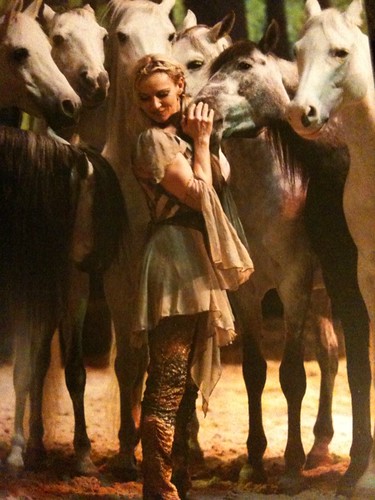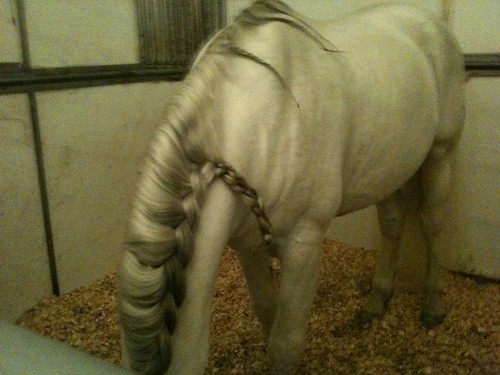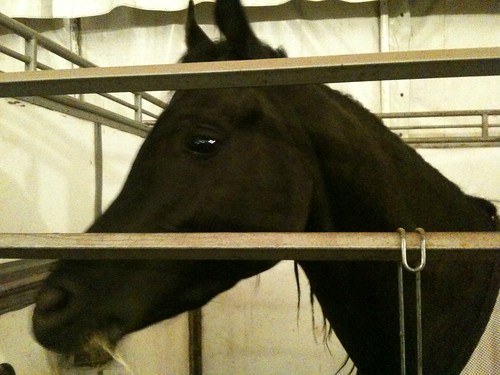And the show was magical. After the opening video, of a mare birthing a foal, two colts galloped across the stage. These colts were said to be rescued just days before the show.
From creator Normand Latourelle:
CAVALIA is...
An ode to beauty
A freedom fantasy
A hymn to harmony
One step towards a new complicity
But aside from the filmed birth scene, all of the 58 horse performers in Cavalia are male, both geldings and stallions. No females. It is astonishing that they can perform complex choreography and rodeo work with stallions. The show's equestrian choreographer says,
"Our philosophy is about understanding the horse, as opposed to making him understand us," explains Frédéric Pignon. His approach to working with stallions at liberty has generated spectacular and unique in the world performances.I wish I knew more about their reasons for choosing to work only with males - although it seems to be a big part of their press, I can't find anything about why. I imagine though that if they want to work with stallions, mares would cause problems. It seems odd though that this step toward a new complicity would be so starkly sexed.

This photo is from the programme - it was my favorite "act" of all - called Grand Liberte'. This woman walked about on stage with all these stallions, alternately allowing them to frolic and play and controlling their actions with soft talking and clicking sounds. It's strange - even disconcerting - to see such huge animals cantering across the stage and *fast* with no reins, leads, nothing. Naked horses.
The horses are of many different breeds - Lusitano, Quarter Horse, P.R.E., Arabian, Paint, and some breeds I've never even heard of like the Comtois and the Criollo. Each breed is suited to the types of "work" displayed in the performances, which ranged from crazy rodeo trick riding to perfect technical dressage.
As entranced as I was by the show, my cynical brain couldn't help but wonder if the respect for the horse was more of a marketing ploy than the reality of their lives. I mean, the show must go on. And even though every horse has an understudy, surely it isn't an easy life. There would be no place for poor performers. The horses are individualized and named and talked about similarly to the human artists in the show. In the programme, even the different breeds ("races" in French) are set forth as comparable to the different nationalities of the human actors, who hail from Canada, Europe, Russia, the U.S., etc. (just like the horses).
I'm sure they have come under fire from the animal rights groups (and specifically the folks who don't think that horses should be ridden or farmed), and their show materials are meant to respond to any objections before they are raised. I wondered if the show was really just a repackaged circus, with prettier music and more romantic sets. But the show actually did explore all these issues - of freedom and captivity, of gender and power, of inter-relationship, through the art which was the show itself.
I always remember how a friend of mine brilliantly said (on kind of a different subject, but not really), "there's no *free* any more, there's just captive and captor." I think Cavalia explores the meaning of freedom within that structure ... the freedom fantasy Latourelle references.
I also loved how the troupe sang to various horse objects, stuffed animals and riding toys, acknowledging the power of the horse imaginary.

These are a few of my pics from the stable tour afterwards, where the horses were busy munching:




Very interesting observations about the horses...they look like magnificent creatures. Somewhere I read that "working" animals in captivity have a more enriched life than say living in a zoo. They have a job and a purpose in life. Surely these animals have a good life....just different than their wild ancestors?
ReplyDeleteBeautiful, I especially love the braided mane. My son just picked out a horse breed encyclopedia from the library two days ago so I've been learning a lot about horses - in place of our usual bedtime books. I had four horses when I was young. I was afraid of them, sort of in awe really. Still am.
ReplyDeleteI grew up on a horse farm and am not surprised that they are using only males. We had some very gentle stallions. And very wild stallions. All depends upon the personality of the animal. Gorgeous photos...makes me miss the horses.
ReplyDeleteSome of your photos remind me of this book "Spirit Horses." You did a good job with them!
thanks everyone for your thoughts! the horses were totally magnificent and awe-inspiring.
ReplyDeletedenise, i agree that working animals tend to have better lives than zoo animals, and maybe even better than companion animals on the whole. but in this case, they don't just claim that their horses are treated well (i'm sure they are!) what surprised me was that they are claiming to be reaching or expressing some new level of human-animal partnership. i guess my vision of an ideal sort of interspecies relationship wouldn't have previously involved horses who are so highly trained that they can run "free" in a crowded theatre... but it worked for me!
charity, i would love to know more about why they would work just with the males. do tell! and is spirit horses the book by gawani pony boy? that is such a beautiful book.